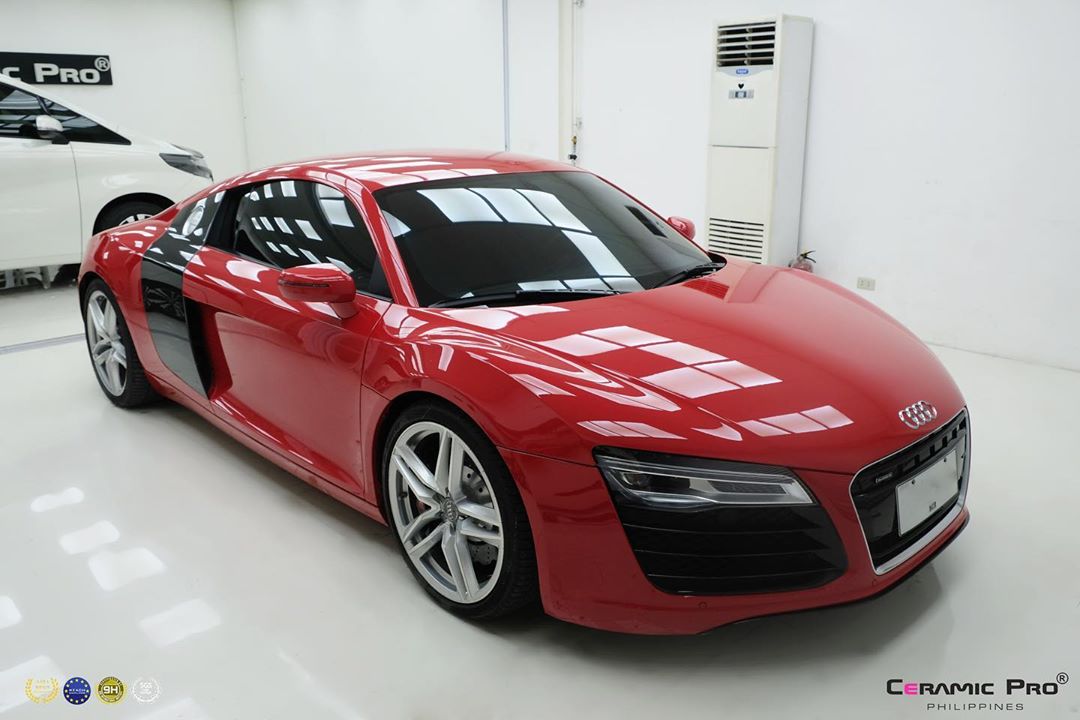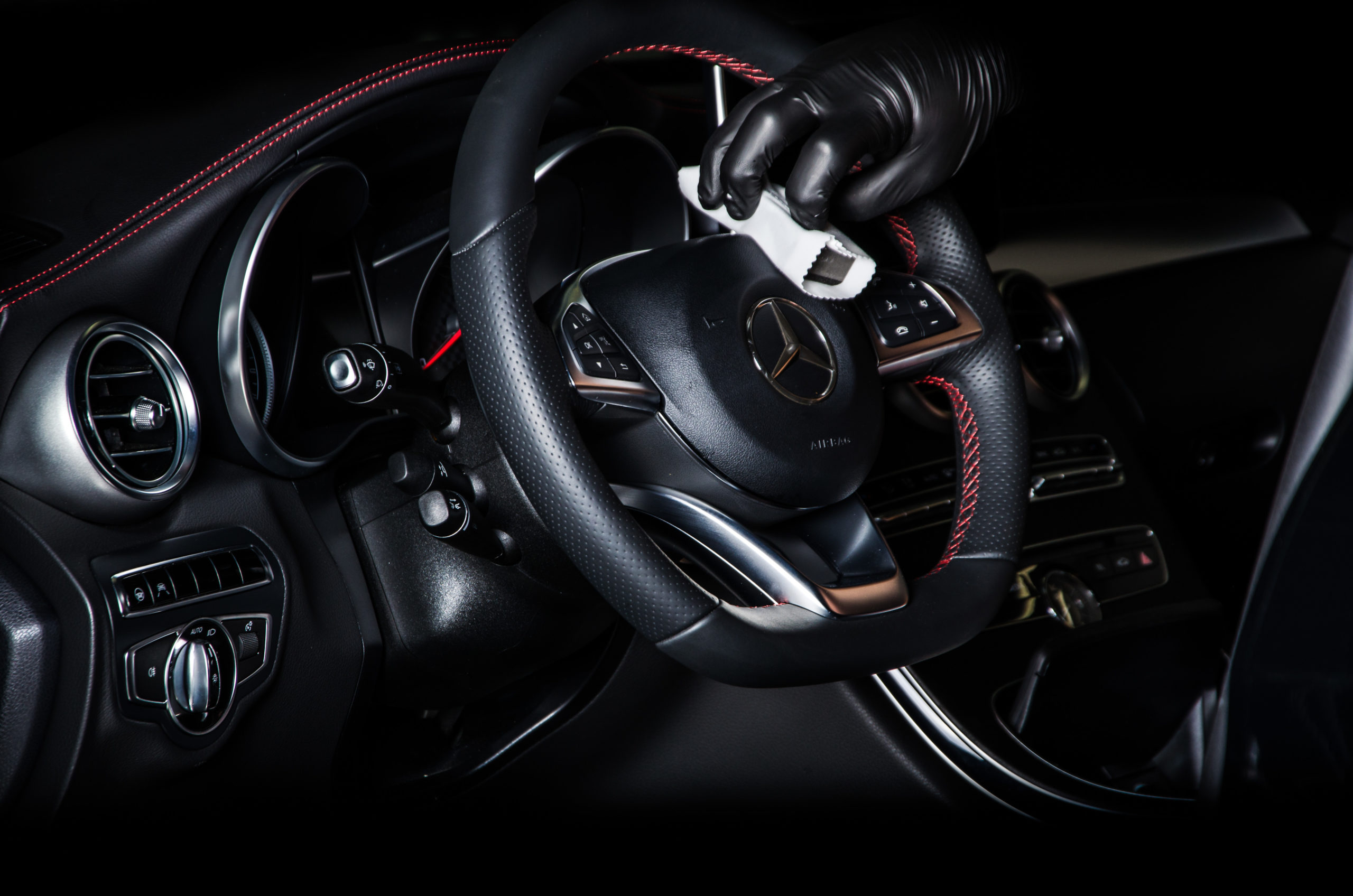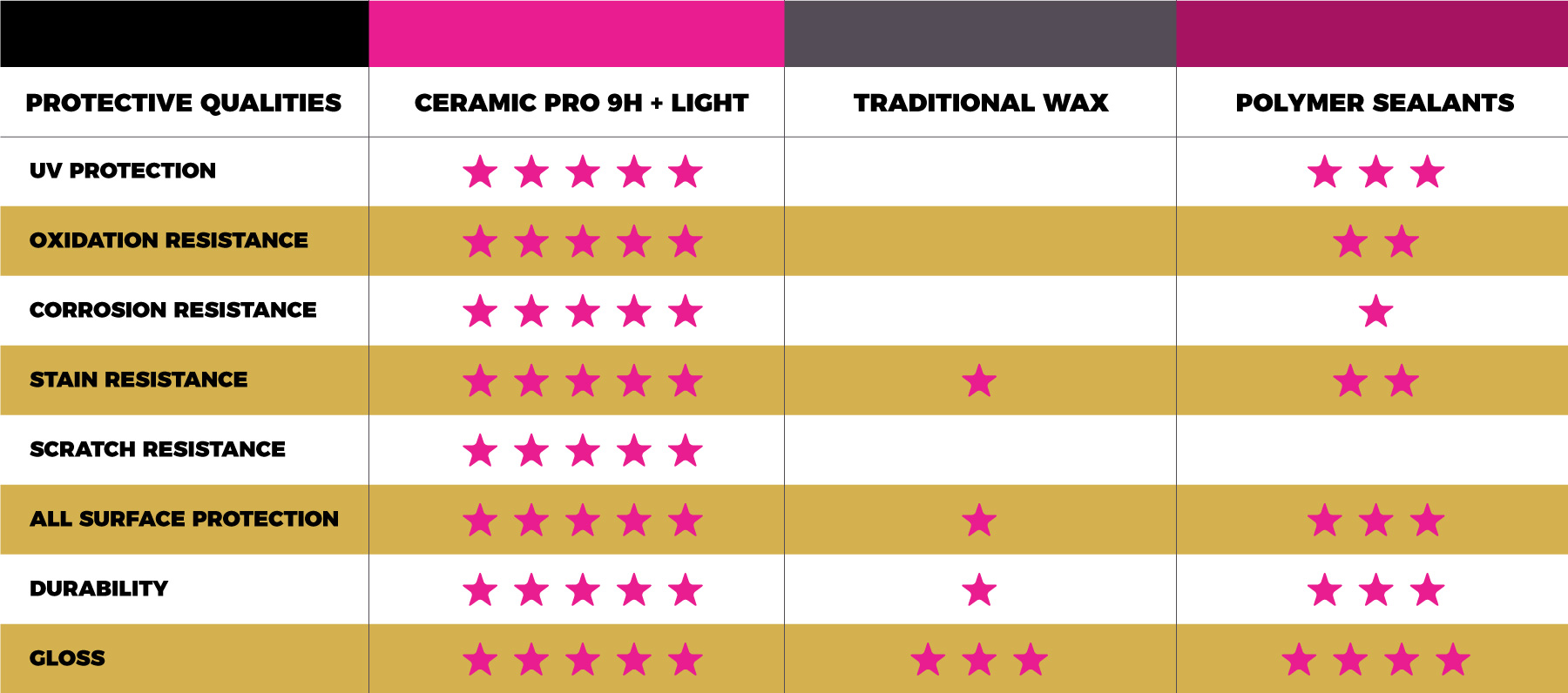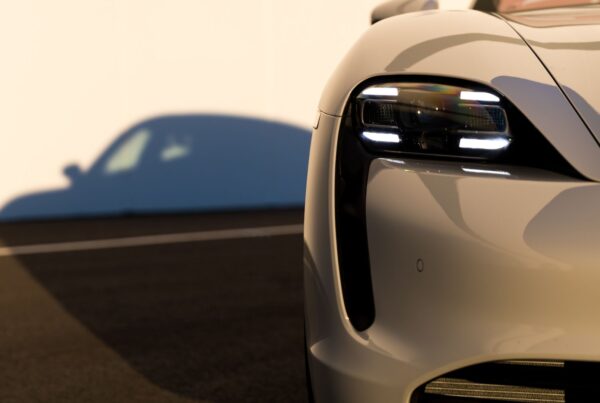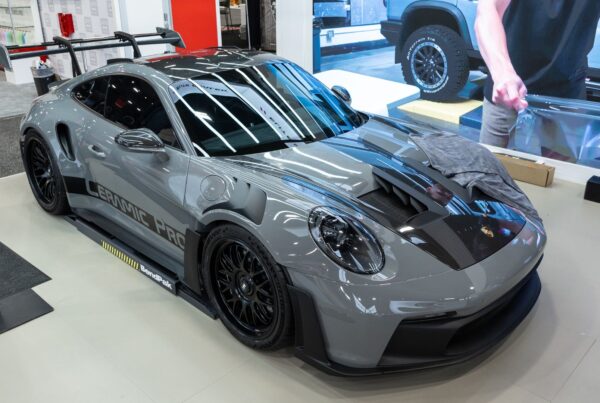DIY Ceramic Coatings vs Professional 9H Coatings
There is nothing wrong with getting your hands dirty. In fact, as a ‘car guy’, I take a lot of pride in fixing stuff using the experience gathered over the years, some good tools, and of course, a bit of blood, sweat and tears. In recent years, do-it-yourself detailers have been rewarded for their passion with a slew of DIY ceramic coatings, easier to apply or watered-down versions of professional coatings. Conversely – this has stimulated a larger slew of ceramic coating myths.
Now don’t get me wrong, there are some good DIY ceramic coating products available today. But there are also several that are nothing more than snake oil in a bottle. In fact, I heard a story not too long ago about a guy who purchased a $30 bottle of ceramic coat from Amazon. He had it tested at a professional lab – only to find out it was 100% corn oil: slippery sure – but providing a 9H hardness, no chance in hades.
The sad news is that the story above is not the only time someone has been deceived by a less-than-stellar DIY paint protection products. There are several myths about nano ceramic coatings that tend to lead people down a path of displeasure. So, let’s talk some turkey about do-it-yourself coatings for car paint.
What is the Difference Between Professional and DIY 9H Ceramic Coating?
To me, there is nothing sweeter than the sound of a precision-tuned, 11,000-horsepower Nitromethane powered hemi engine crossing the 1,000-foot drag strip at 330 miles per hour – except perhaps being in the seat of said dragster. However, since I don’t have an unlimited bankroll, nor the courage to strap into one of those monsters, you’ll find me racing a 170mph bracket car instead.
While both cars are a lot of fun to watch and drive, comparing the two is simply not at an apple-to-apple level. Heck, it’s not even fair to compare it on a fruit-to-fruit basis. Such is the case when pairing a professional ceramic coat to a DIY ceramic car coating on equal footing.
While they both are designed to improve auto detailing and provide a semi-permanent and 9H hardness layer of protection on your car’s factory paint, glass, and wheels, reduce swirl marks and enhance the car’s paint, the way they achieve that goal and the quality is night and day.
Since we’re positive-minded folks, let’s start with the similarities.
- The raw ingredients: A nano ceramic coating is comprised of three major ingredients; silicon dioxide (SiO2), titanium dioxide (TiO2) and carrier solvents.
- The general application: The professional-grade and DIY ceramic coating are essentially applied in a similar fashion. A highly-concentrated formula is applied to a microfiber or suede applicator cloth, applied to a smaller section of the vehicle, then buffed off after it has flashed or initially bonded to the surface.
- Highly-Concentrated: The DIY car ceramic coating and professional coating like Ceramic Pro 9H are both highly-concentrated solutions. In fact, one 30 or 50ml bottle is usually enough coating for the average coupe or sedan.
While these two products might appear similar on the outside or in the way they are applied, there are multiple differences in each of the above categories that should be clarified.
Percentage of Raw Ingredients: DIY ceramic coatings actively boast about their high SiO2 percentages, with some even claiming up to 84 percent of this awesome ingredient. Most of them hover in the 70 percent SiO2 range. Professional coatings have about 65% SiO2. So, what does SiO2 have to do with the ceramic coating effectiveness?
Silicon dioxide is the ingredient that helps produce the ultra-flat layer on top of the coating that makes it super slippery. While higher SiO2 will create a super hydrophobic surface, that doesn’t mean the coated vehicle will last longer – or produce the best hydrophobic properties.
Allow me to articulate this to you. There are multiple variables that impact the water-sheeting goodness of a ceramic nano coating.
The Application Process: The key to producing that incredible water-sheeting hydrophobic properties is building the layer of coatings gradually on top of each other. With each layer of 9H coating, the surface becomes gradually flatter. This is accomplished with the third major ingredient – or carrier solvents. The higher grade of carrier solvents allows the automotive ceramic coating to be layered.
The tradeoff is ease of installation. A DIY glass coating is made for the average auto enthusiast to apply in their garage – with little training or special equipment. Ceramic Pro 9H contains advanced carrier solvent ingredients that are quite difficult to apply – even for the experienced detailer.
Does a DIY Ceramic Coating Require Paint Correction?
One of the biggest myths in the car detailing world is that a DIY coat of ceramic does not need paint correction. That’s simply inaccurate. Small scratches can be filled in by some car wax products, but for the car ceramic coating to bond to the vehicle’s paint, all that wax needs to be removed.
The imperfections and damage to the car’s exterior need to be polished off – which is what paint correction is. It’s a process of cutting into the clear coat or top layer of a substrate to level to the point where damage is reduced.
By removing those swirl marks, it can improve the gloss of paint, which is amplified by the coatings. Installing a paint protection film on top of the freshly prepped surface will provide that extra layer of protection and superior scratch resistance.
Which Lasts Longer – Professional or DIY Ceramic Coatings?
The average DIY 9H ceramic coating has an expected longevity of 2 years. In fact, of all the ceramic paint protection for do-it-yourself consumers on the internet today, only one comes with any expected longevity warranty – Armor Shield IX.
They provide a two-year ‘expected longevity warranty’ – which means they’ll refund the purchase price. From what we’ve seen from their customers, they stand by this – and offer good service across the board – so good on them for being the unicorn of the DIY coating world.
Ceramic Pro offers our customers three package options – all based on the longevity desired.
- 2-Year Warranty – Our entry point is the Bronze Package, which consist of a single layer of Ceramic Pro Top Coat. It protects against light scratching, produces exceptional hydrophobic properties, and reduces UV exposure – keeping your factory paint fresh and clean.
- 5-Year Warranty – The Silver Package includes a single layer of Ceramic Pro 9H serving as the base – with an additional layer of Ceramic Pro Top Coat. This package elevates your ceramic paint coating nearly 200% longer than the best DIY ceramic coating.
- Lifetime Warranty – The Mount Everest of Ceramic Pro coatings is the Gold Package. Starting with 4 coats of Ceramic Pro 9H as the foundation, an extra layer on exposed areas like the front end, finishing with a Top Coat, your daily driver, collectible or other prized automobile with be protected for its lifespan.
Is a DIY Nano Coating Easy to Apply?
Easy is a relative term – but overall, applying them is not complex. When you opt for the DIY ceramic coating, you’ll be facing multiple variables that can impact the quality of your coating experience.
Regardless of which ceramic coating you choose, the location where the coating is applied to paintwork and other substrates is crucial. Due to its unique formulation of carrier solvents, SiO2 and TiO2 a highly-concentrated nano coating must be applied in a temperature-controlled environment. While many DIY coatings are more forgiving, there are some general rules of thumb.
- They can’t be applied in direct sunlight: A freshly coated car, truck, SUV, or motorcycle looks phenomenal in sunlight. But, it’s impossible to apply a nano coating in direct sunlight. This means, no outdoor applications unless it’s early morning or right after sunset.
- Temperature variance: Most ceramic coatings have a temperature application range from 50 to 80 degrees F. The coating will not bond to the surface of any substrate if it’s too hot or cold.
- Humidity: Applying a DIY ceramic coating when it’s warmer than 70 degrees and higher than 50% humidity is also a challenge. The added water grains can accelerate the flashing process, which makes it difficult to buff off.
- Surface temperature: If the vehicle’s paint surface – body panels, wheels, plastic trim, and such are warm to the touch, the coating will quickly flash, and become nearly impossible to remove. This leads to a jagged finish and poor performance.
- The amount of coating used: A DIY coating might come with instructions, but they usually say, “apply 3 to 8 drops of coating per section.” That’s a bit vague – huh? If you have too much formula, it’ll take longer to flash. Too little coverage results in a thin coat which won’t last long.
A professional Ceramic Pro 9H coating is always applied at certified auto salons by highly-trained and experienced technicians. The facility is temperature controlled, which creates a near perfect location to apply the coating – which provides more consistent results. Additionally, prior to applying any ceramic coating, paint correction or polishing out imperfections is strongly suggested.
Does a DIY Nano Coating Provide the Best Protection?
Not really. We spoke about the role that SiO2 has in the overall quality of a ceramic coating. But what creates the hardness? This is direct result of the combination of the formula – and the ability to provide depth to the coating – which is accomplished by way of layering the product.
So, what is this TiO2 stuff that is included in the proprietary blend of ceramic car coatings? Well, you might be shocked to learn that it’s a naturally-occurring mineral that is added to many common food products for the direct purpose of increasing the luster or shine. Remember that cereal varnish that Clark Griswold was working on in Christmas Vacation – yeah, likely TiO2 infused.
But, TiO2 also serves another important purpose – besides helping to improve shine of a clear coat. It helps to block harmful UV rays from penetrating the surface that is protected by the coating. You’ll find more TiO2 in a professional-grade coating vs a DIY coating. Again, this ingredient does have an impact in the application process.
The key to offering superior protection against UV rays or exposure, animal waste, light chemicals, and yes – even those dreaded light ROCKCHIPS, is providing more layers of the coating. Thus – with a DIY coating and only 1 solid layer possible, protection against these items is not going to be as strong as a professional-grade product – nor will it last longer.
Is a DIY Ceramic Coating Snake Oil?
Not all of them. In fact, most DIY ceramic coatings are good products and serve a purpose to a specific consumer group. If you’re looking for a better paint protection coating than a paint sealant, that should last a few years, and are a dedicated DIY enthusiast, the high-end grade of these products will serve you well.
But, in full transparency, there are a few things you need to consider before walking down the DIY ceramic coating path.
- Prep Work is Tedious: Any nano ceramic coating will amplify the surface underneath. It doesn’t fix or fill scratches or paint damage. As such, if you’re going to apply a DIY ceramic coating, you’ll have to complete paint correction first – which is polishing scratches out of the clear coat. If you’re not comfortable with this level of DIY paint repair, the auto salons who apply Ceramic Pro 9H can handle that – and apply a higher-quality, longer lasting coating right after.
- Applying is Tricky: We mentioned this in detail above. But it’s important reinforce this fact. It might seem easy or simple to apply, but that doesn’t always mean that the coating is correctly bonded. The perfect success rate with DIY coating applications is less than 50% of the time.
- Must Remove the Coating Before Adding More: Since the DIY nano coating is not formulated to layer on top of each coat, it needs to be fully removed by paint correction or using potentially harmful chemical agents. This can damage your clear coat – so beware.
- It’s a Buyer Beware Industry: While the DIY route is cheaper, you often get what you pay for. All these products are sold online, and to be quite honest, there is a lot of questions about who owns and runs these companies. Just make sure to research these businesses, and if you can’t talk to someone about them, that’s usually a red flag.
If the variables above don’t match your comfort level, or if you’d rather have a longer lasting, higher-quality ceramic coating for your car, click the button below to locate a Ceramic Pro auto salon near you and receive a free estimate.



